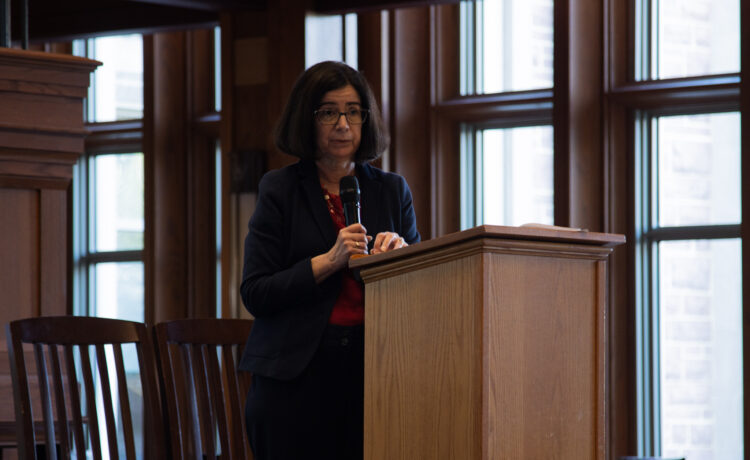
(Bri Nitsberg | Student Life)
Student Union hosted a Financial Overview detailing spending and income, future financial plans for the University, and how tuition is used in Tisch Commons on March 28.
The event, which was moderated by Vice Chancellor Anna Gonzalez, was attended by approximately 20 individuals, mostly students. Featured panelists included Chief Financial Officer Amy Kweskin and Director of Student Financial Services Mike Runiewicz.
According to Student Union Executive Vice President Hussein Amuri, the event was reestablished in hopes of increasing financial transparency on campus, four years after the event had been discontinued.
“Due to the COVID pandemic, we lost so many traditions,” Amuri said. “But it was my and the executive team’s goal to bring the Overview back because tuition is something that affects all of us.”
Kweskin began the event with an overview of the University’s 2023 fiscal year. She said WashU’s total expenditure totaled $4.6 billion dollars, consisting of $3.5 billion dollars allocated to the School of Medicine and $1.1 billion dollars allocated to the Danforth Campus.
She said a significant portion of the School of Medicine’s expenditure falls under providing healthcare. Kweskin also emphasized the cost of staff compensation, the largest category within WashU’s budget at 61%, or $2.77 billion.
“That is all the faculty teaching you, all the staff supporting you,” Kweskin said. “Also, the doctors down at the hospital. These are the people working at the University that make up the bulk of the expenses.”
Kweskin later said the bulk of WashU’s revenue came from clinical care at $2.2 billion, followed by research funding at $853 million, endowment payouts at $570 million, and tuition at $497 million. This left the University with roughly $200 million dollars of surplus.
Kweskin talked about the affordability of WashU compared to its peer universities. She featured two tables showing both WashU tuition and tuition increases being lower than the majority of peer universities.
“Our increase last year was high, so we brought it back down,” Kweskin said. “You can see we’re still a bit lower than [our peers].”
She followed up by saying the typical cost of attending WashU is around $22,000, 25% of the $87,644 published attendance cost.
Both Kweskin and Gonzalez emphasized the importance of Here and Next, a strategic plan and fundraising initiative for WashU’s endowment. They said a larger endowment would better help the University grow its research output and support its students.
When compared to peer universities, WashU’s endowment size falls below the median. This discrepancy has affected funding for need-based scholarships, as the scholarships have to be funded from alternative sources than the endowment.
The presenters said that a larger endowment would allow all students to be financially supported in both scholarship and research endeavors, such as through stipends for students pursuing low-paying internships and apprenticeships.
Amuri hopes to make the University Financial Overview a yearly tradition once again.
“Some of these admins are incredibly busy, and all this information can be difficult to get, but I think we made a breakthrough,” Amuri said. “The Financial Overview meant so much to people before the pandemic, and it means just as much now.”

















